
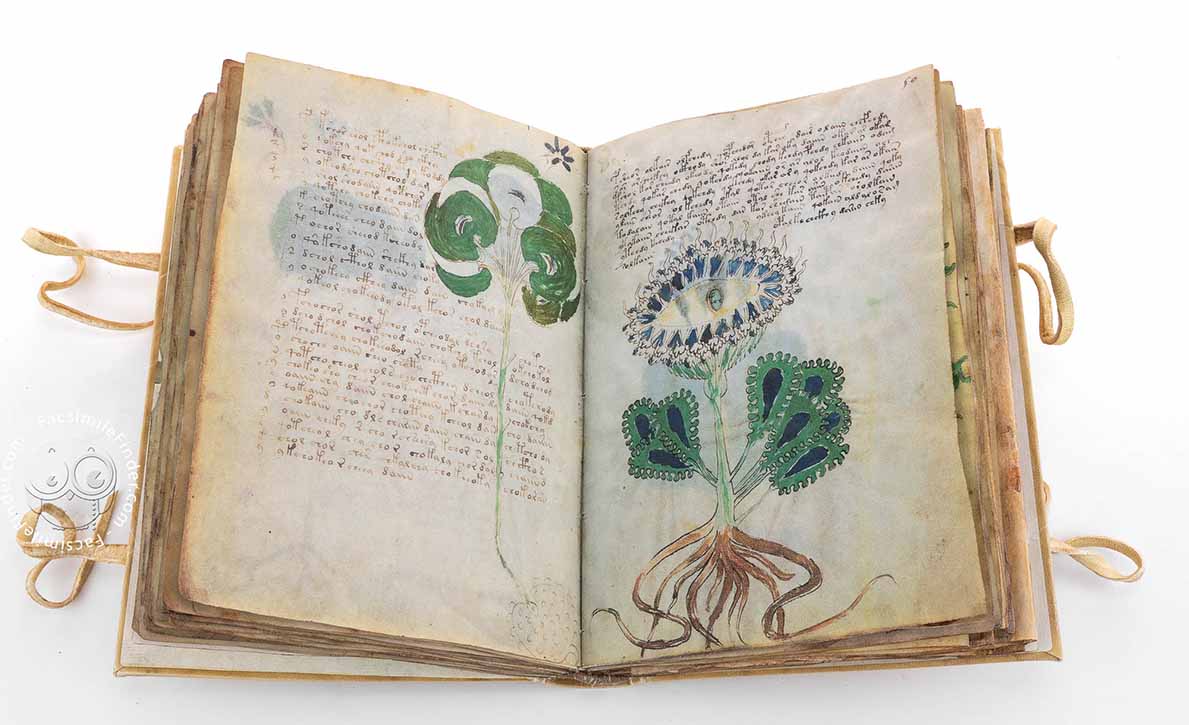


The Voynich Manuscript has been dubbed "The Most Mysterious Manuscript in the World". It is considered a Manuscript codex and dates to the early 15th century (1404-1438), possibly created in northern Italy. It is named after the book dealer Wilfrid Voynich, who purchased it in 1912. Some pages are missing, but there are now about 240 vellum pages, most with illustrations. It's size is 23.5 by 16.2 by 5 centimeters (9.3 by 6.4 by 2.0 in).
Much of the manuscript resembles herbal manuscripts of the 1500s, seeming to present illustrations and information about plants and their possible uses for medical purposes. However, most of the plants do not match known species, and the manuscript's script and language remain unknown.
Possibly some form of encrypted cipher-text, the Voynich manuscript has been studied by many professional and amateur cryptographers, including American and British codebreakers from both World War I and World War II. It has defied all decipherment attempts, becoming a famous case of historical cryptology. The mystery surrounding it has excited the popular imagination, making the manuscript a subject of both fanciful theories and novels. None of the many speculative solutions proposed over the last hundred years has yet been independently verified. The Voynich manuscript was donated to Yale University's Beinecke Rare Book and Manuscript Library in 1969, where it is catalogued under call number MS 408 and called a "Cipher Manuscript".
We will never fully understand all of the messages - some easy to discern while others resemble allegory making them subjective to the reader. Many of the images follow basic iconography found in other ancient texts. The history of the manuscript takes us to alchemy, creation, and the way the world appeared to the author hundreds of year ago. I believe one man wrote the book over many years, if not decades, to explain his theory of the way the universe works, as well as being used as a healing tool - all of which still remain the fundamental foundations to answers we seek in the twenty-first century. The secrecy and cryptic aspects make it fascinating. Wherever your journey is taking you, there will be some message in the book. A HREF="https://en.wikipedia.org/wiki/Voynich_manuscript">Continue reading
Mysterious Voynich manuscript may be a cipher, a new study suggests Live Science - January 4, 2026

A newly invented cipher may shed light on how the mysterious Voynich manuscript was made in medieval times. A unique cipher that uses playing cards and dice to turn languages into glyphs produces text eerily similar to the glyphs in the Voynich manuscript, a new study shows. The finding suggests that an equivalent cipher could have been used to create the mysterious medieval manuscript. The new cipher called "Naibbe," from the name of a 14th-century Italian card game - does not decode the medieval Voynich manuscript, but it offers an idea for how the manuscript was made.
The Voynich manuscript, which has been radiocarbon-dated to the 15th century, contains roughly 38,000 words written in glyphs that have never been translated. Despite more than a century of intense scrutiny, the manuscript has not been explained conclusively. However, it continues to intrigue people, with its bizarre and inexplicable illustrations of plants, astrology and alchemy, including supposedly "biological" depictions of bathing naked women.
Voynich Manuscript Finally Decoded? Medieval Sex Secrets May Hide in Mysterious Text Science Alert - April 17, 2024
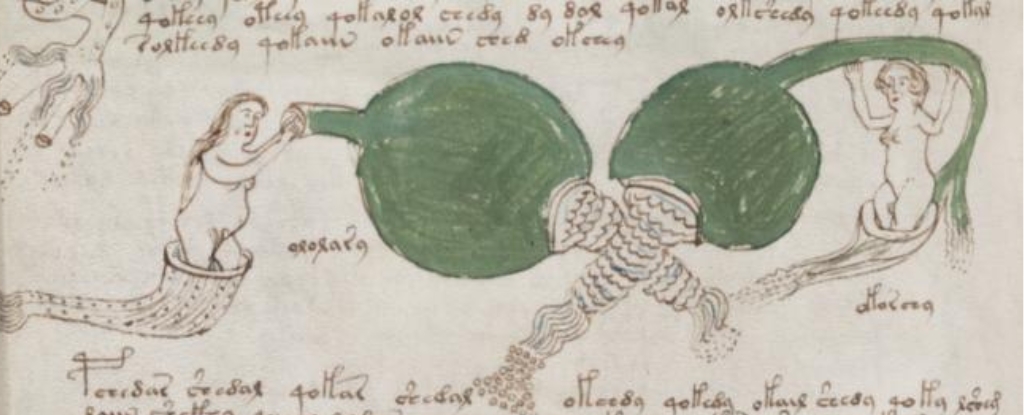
The Voynich manuscript has long puzzled and fascinated historians and the public. This late-medieval document is covered in illustrations of stars and planets, plants, zodiac symbols, naked women, and blue and green fluids. But the text itself - thought to be the work of five different scribes - is enciphered and yet to be understood.
Research on the Voynich manuscript has revealed some clues about its origins. Carbon dating provides a 95% probability the skins used to make the manuscript come from animals that died between 1404 and 1438. However, its earliest securely known owner was an associate of Holy Roman Emperor Rudolf II, who lived from 1552 to 1612, which leaves more than a century of ownership missing. Certain illustrations (the zodiac symbols, a crown design and a particular shape of castle wall called a swallowtail merlon) indicate the manuscript was made in the southern Germanic or northern Italian cultural areas.
One section contains illustrations of naked women holding objects adjacent to, or oriented towards, their genitalia. These wouldn't belong in a solely herbal or astronomical manuscript. To make sense of these images, we investigated the culture of late-medieval gynecology and sexology - which physicians at the time often referred to as "women's secrets".
Are we closer to solving the mystery of the 600-year-old Voynich manuscript? AI claims to have cracked the code in the 'world's most mysterious book' Daily Mail - January 30, 2018
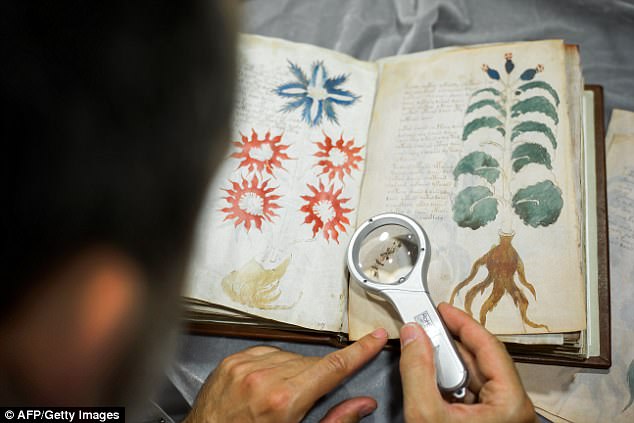
or centuries people have tried to decipher the meaning of the Voynich manuscript, and now a computer scientist claims to have cracked it using AI. The 600-year-old document is described as 'the world's most mysterious medieval text', and is full of illustrations of exotic plants, stars, and mysterious human figures. The 240-page manual's intriguing mix of elegant writing and drawings of strange plants and naked women has some believing it holds magical powers. But even the cryptographers from Bletchley Park, the team that broke the Nazi enigma code, couldn't make sense of the manuscript. Now a computer scientist says the manuscript is written in ancient Hebrew and the code involves shuffling the order of letters in each word and dropping the vowels. While his is still to decipher its full meaning, he believes the first sentence of the text says: 'he made recommendations to the priest, man of the house and me and people.'
Author of mysterious Voynich manuscript was Italian Jew, says scholar The Guardian - July 7, 2017
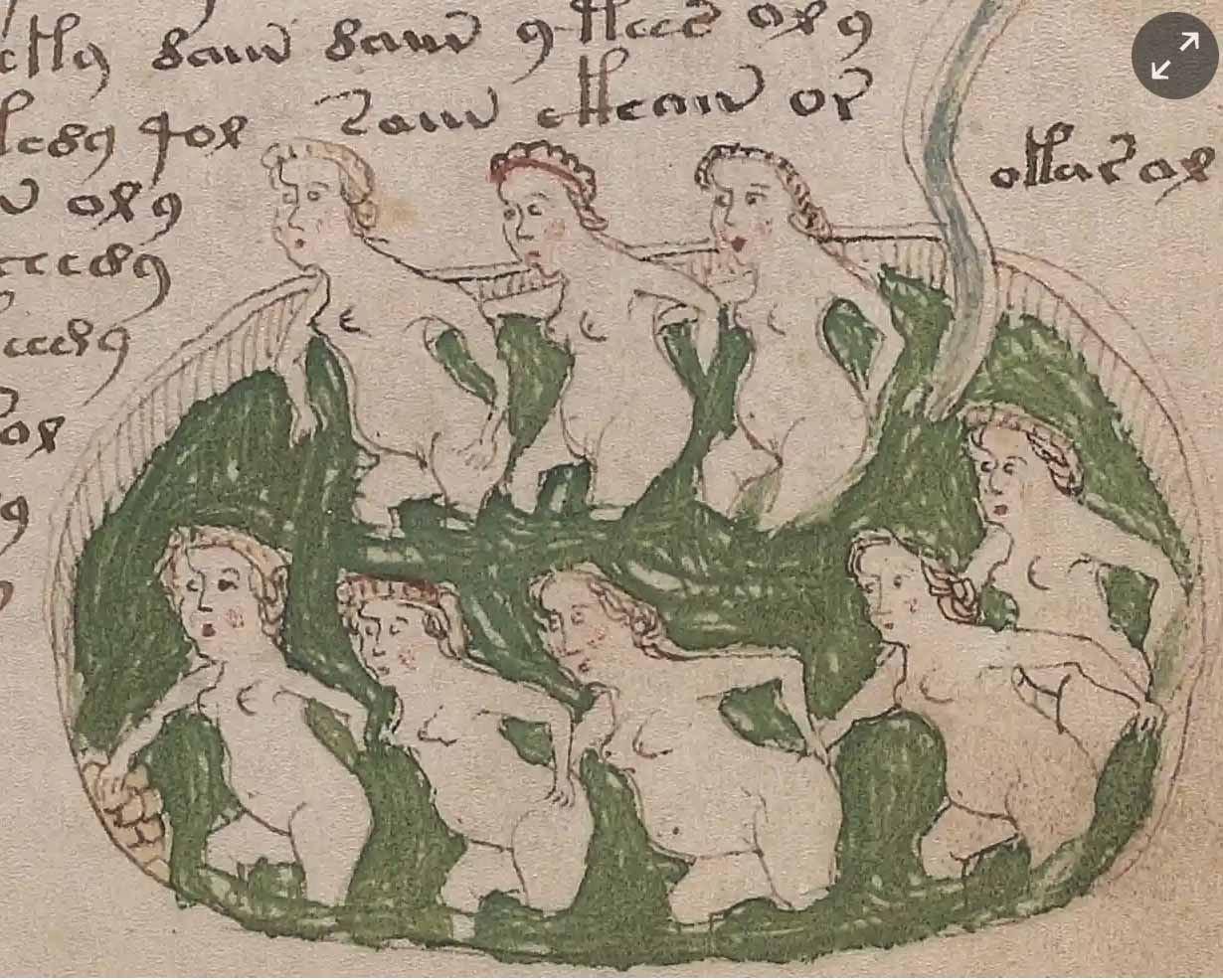
One of the world's most confounding literary mysteries may finally be, in part, solved: the author of the mysterious and as-yet untranslatable Voynich manuscript has been identified as a Jewish physician based in northern Italy, an expert in medieval manuscripts has claimed. The Voynich manuscript is an illustrated book printed on vellum written entirely in an indecipherable script, leaving scholars and code-breakers scratching their heads since it re-emerged a century ago. Writing in the foreword of a new facsimile of the 15th-century codex, Stephen Skinner claims visual clues in each section provide evidence of the manuscript's author. If proved true, Skinner believes his theory will help unlock more secrets of the coded manuscript.
The scholar draws evidence for his theory of the author's identity from a range of illustrations in the manuscript, particularly a section in which naked women are depicted bathing in green pools supplied by intestinal-like pipes. The doctor, whose work includes editing the spiritual diaries of the Tudor mystic John Dee, believes the illustrations show communal Jewish baths called mikvah, which are still used in Orthodox Judaism to clean women after childbirth or menstruation.
Mysterious Voynich manuscript has 'genuine message' BBC - June 23, 2013
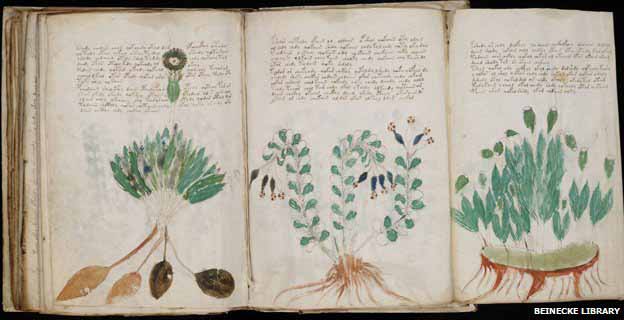
The message inside "the world's most mysterious medieval manuscript" has eluded cryptographers, mathematicians and linguists for over a century. And for many, the so-called Voynich book is assumed to be a hoax. But a new study, published in the journal Plos One, suggests the manuscript may, after all, hold a genuine message. Scientists say they found linguistic patterns they believe to be meaningful words within the text.
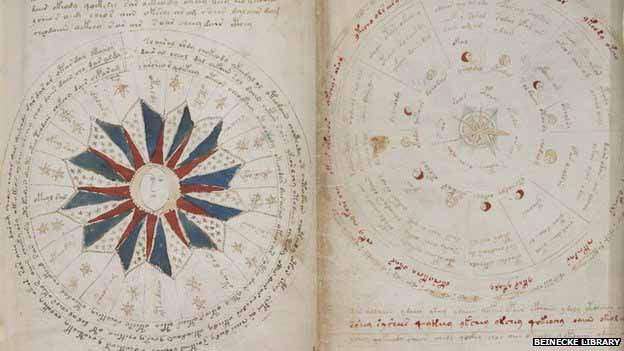
Analysts have split the book into five thematic sections based on the illustrations: biological, astrological, pharmaceutical, herbal and one section on recipes
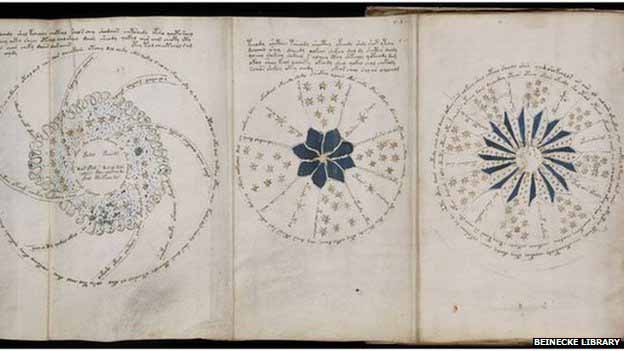
Whether or not it really does have any meaningful information, though, is much debated by amateurs and professionals alike. It was even investigated by a team of prominent code breakers during WWII who successfully cracked complex encrypted enemy messages, but they failed to find meaning in the text.
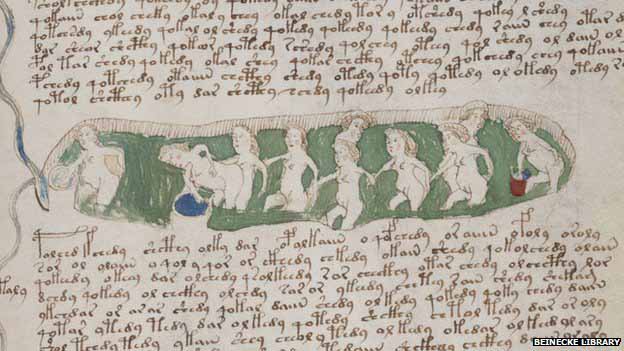
The book has been dated to the early 1400s, but it largely disappeared from public record until 1912 when an antique book dealer called Wilfrid Voynich bought it amongst a number of second-hand publications in Italy.
Historically, it first appears in 1586 at the court of Rudolph II of Bohemia, who was one of the most eccentric European monarchs of that or any other period. Rudolph collected dwarfs and had a regiment of giants in his army. He was surrounded by astrologers, and he was fascinated by games and codes and music. He was typical of the occult-oriented, Protestant noblemen of this period and epitomized the liberated northern European prince. he was a patron of alchemy and supported the printing of alchemical literature.
The Rosicrucian conspiracy was being quietly fomented during this same period. To Rudolph's court came an unknown person who sold this manuscript to the king for three hundred gold ducats, which, translated into modern monetary units, is about fourteen thousand dollars. This is an astonishing amount of money to have paid for a manuscript at that time, which indicated that the Emperor must have been highly impressed by it.
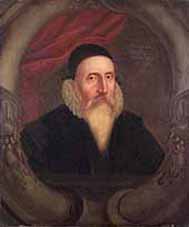
Accompanying the manuscript was a letter that stated that it was the work of the Englishman Roger Bacon, who flourished in the thirteenth century and who was a noted pre-Copernican astronomer. Only two years before the appearance of the Voynich Manuscript, John Dee the great English navigator, astrologer, magician, intelligence agent, and occultist had lectured in Prague on Bacon.
The manuscript somehow passed to Jacobus de Tepenecz, the director of Rudolph's botanical gardens (his signature is present in folio 1r) and it is speculated that this must have happened after 1608, when Jacobus Horcicki received his title 'de Tepenecz'. Thus 1608 is the earliest definite date for the Manuscript.
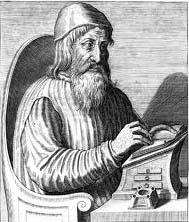
Codes from the early sixteenth century onward in Europe were all derived from The Stenographica of Johannes Trethemius, Bishop of Sponheim, an alchemist who wrote on the encripherment of secret messages. He had a limited number of methods, and no military, alchemical, religious, or political code was composed by any other means throughout a period that lasted well into the seventeenth century. Yet the Voynich Manuscript does not appear to have any relationship to the codes derivative of Johannes Trethemius, Bishop of Sponheim.
In 1622 and the manuscript passed to the possession of an unidentified individual that left the book in his/her will to Marci. Marci must have known about this manuscript before 1644, as the information concerning the price that the Emperor paid came from Dr. Raphael Missowski (1580-1644) (as mentioned in his letter).
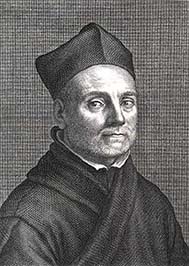
Marci sent the manuscript immediately with the letter to Athanasius Kircher (a Jesuit priest and scholar in Rome) in 1666 who apparently also knew of it and had exchanged letters and transcribed portions with the previous unidentified owner.
Between that time and 1912 (when Voynich discovered it) it is speculated that the manuscript may have been stored or forgotten in some library and finally moved to the Jesuit College at the Villa Mondragone. Marci's letter to Kircher was still attached to the manuscript when Voynich bought it.
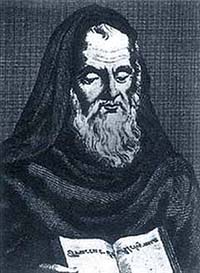
In that letter, Marci mentioned the name of Roger Bacon (1214-1292) as a possible author, although no conclusive evidence of authorship is available. A possible link between Rudolph and Bacon is John Dee (an English mathematician and astrologer, collector of Bacon's work) who visited Rudolph's court in 1582-86.
The history of the manuscript is still full of gaps, especially in its earliest part. Since the manuscript's alphabet does not resemble any known script, and the text is still undeciphered, the only useful evidence as to the book's age and origin are the illustrations - especially the dress and hairstyles of the human figures, and a couple of castles that are seen in the diagrams. They are all characteristically European, and based on that evidence most experts assign the book to dates between 1450 and 1520. This estimate is supported by other secondary clues.
The earliest confirmed owner of the manuscript was a certain Georg Baresch, an obscure alchemist who lived in Prague in the early 17th century. Baresch apparently was just as puzzled as we are today about this "Sphynx" that had been "taking up space uselessly in his library" for many years.
On learning that Athanasius Kircher, a Jesuit scholar from the Collegio Romano, had published a Coptic (Ethiopian) dictionary and "deciphered" the Egyptian hieroglyphs, he sent a sample copy of the script to Kircher in Rome (twice), asking for clues.
His 1639 letter to Kircher, which was recently located by Rene Zandbergen, is the earliest mention of the manuscript that has been found so far.
It is not known whether Kircher answered the request, but apparently he was interested enough to try to acquire the book, which Baresch apparently refused to yield.
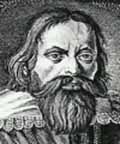
Upon Baresch's death the manuscript passed to his friend Jan Marek Marci (Johannes Marcus Marci), then rector of Charles University in Prague; who promptly sent the book to Kircher, his longtime friend and correspondent. Marci's cover letter (1666) is still attached to the manuscript.
There are no records of the book for the next 200 years, but in all likelihood it was kept, with the rest of Kircher's correspondence, in the library of the Collegio Romano (now the Pontifical Gregorian University). It probably remained there until the troops of Victor Emmanuel II of Italy captured the city in 1870 and annexed the Papal States.
The new Italian government decided to confiscate many properties of the Church, including the library of the Collegio. According to investigations by Xavier Ceccaldi and others, just before this happened many books of the University's library were hastily transferred to the personal libraries of its faculty, which were exempt from confiscation.
Kircher's correspondence was among those books and so apparently was the Voynich manuscript, as it still bears the ex libris of Petrus Beckx, head of the Jesuit order and the University's Rector at the time.
Beckx's "private" library was moved to the Villa Mondragone, Frascati, a large country palace near Rome that had been bought by the Society of Jesus in 1866 and housed the headquarters of the Jesuits' Collegio Ghisleri.
Around 1912 the Collegio Romano was apparently short of money and decided to sell (very discreetly) some of its holdings.
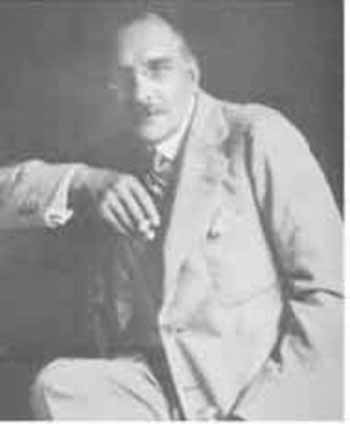
Wilfrid Voynich acquired 30 manuscripts, among them the manuscript that now bears his name. In 1930, after his death, the manuscript was inherited by his widow Ethel Lilian Voynich (known as the author of the novel The Gadfly).
She died in 1960 and left the manuscript to her close friend, Miss Anne Nill. In 1961, Anne Nill sold the book to another antique book dealer Hans P. Kraus. Unable to find a buyer, Kraus donated the manuscript to Yale University in 1969.
Over its recorded existence, the Voynich manuscript has been the object of intense study by many professional and amateur cryptographers, including some top American and British codebreakers of World War II fame (all of whom failed to decipher a single word). This string of failures has turned the Voynich manuscript into a famous subject of historical cryptology, but it has also given weight to the theory that the book is simply an elaborate hoax - a meaningless sequence of arbitrary symbols.
The book is named after the Polish-American book dealer Wilfrid M. Voynich, who acquired it in 1912. As of 2005, the Voynich manuscript is item MS 408 in the Beinecke Rare Book Library of Yale University. The first facsimile edition was published in 2005
The book was bought by H. P. Kraus (a New York book antiquarian) in 1961 for the sum of $24,500. He later valued it at $160,000 but was unable to find a buyer. Finally he donated it to Yale University in 1969, where it remains to date at the Beinecke Rare Book Library with catalogue number MS 408. It is known (from a letter of Johannes Marcus Marci to Athanasius Kircher dated 1666) that the manuscript was bought by Emperor Rudolph II of Bohemia (1552-1612).
Many names have been proposed as possible authors of the Voynich manuscript. Here are only the most popular ones linked to alchemists.
Roger Bacon Marci's 1665 cover letter to Kircher says that, according to his late friend Raphael Mnishovsky, the book had once been bought by Emperor Rudolf II of Bohemia (1552-1612) for 600 ducats - around $30,800 as of 2005. According to the letter, Rudolf (or perhaps Raphael) believed the author to be the Franciscan friar and polymath Roger Bacon (1214-1294).
Even though Marci said that he was "suspending his judgement" about this claim, it was taken quite seriously by Voynich, who did his best to confirm it. His conviction strongly influenced most decipherment attempts for the next 80 years. However, scholars who have looked at the Voynich manuscript and are familiar with Bacon's works have flatly denied that possibility. One should note also that Raphael died in 1644, and the deal must have occurred before Rudolf's abdication in 1611 - at least 55 years before Marci's letter.
John Dee - The assumption that Roger Bacon was the author led Voynich to conclude that the person who sold the Voynich manuscript to Rudolf could only be John Dee, a mathematician and astrologer at the court of Queen Elizabeth I, known to have owned a large collection of Bacon's manuscripts. Dee and his scrier (mediumic assistant) Edward Kelley lived in Bohemia for several years where they had hoped to sell their services to the Emperor. However, Dee's meticulously kept diaries do not mention that sale, and make it seem quite unlikely. Anyway, if the Voynich manuscript author is not Bacon, the connection to Dee may just disappear. On the other hand, Dee himself may have written it and spread the rumour that it was originally a work of Bacon's in the hopes of later selling it.
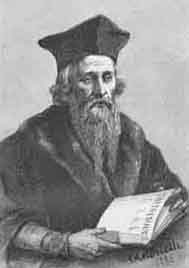
Edward Kelley - Dee's companion in Prague, Edward Kelley, was a self-styled alchemist who claimed to be able to turn copper into gold by means of a secret powder which he had dug out of a Bishop's tomb in Wales. As Dee's scrier, he claimed to be able to invoke angels through a crystal ball, and had long conversations with them - which Dee dutifully noted down. The angel's language was called Enochian, after Enoch, the Biblical father of Methuselah; according to legend, he had been taken on a tour of Heaven by angels, and later written a book about what he saw there. Several people have suggested that, just as Kelley invented Enochian to dupe Dee, he could have fabricated the Voynich manuscript to swindle the Emperor (who was already paying Kelley for his supposed alchemical expertise). However, if Roger Bacon is not the author of the Voynich manuscript, Kelley's connection to the manuscript is just as vacuous as Dee's.
Wilfrid Voynich was often suspected of having fabricated the Voynich manuscript himself. As an antique book dealer, he probably had the necessary knowledge and means; and a "lost book" by Roger Bacon would have been worth a fortune. However, by expert dating of the manuscript, and the recent discovery of Baresch's letter to Kircher, that possibility has been eliminated.
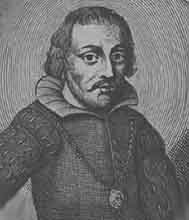
Jacobus Sinapius - A photostatic reproduction of the first page of the Voynich manuscript, taken by Voynich sometime before 1921, showed some faint writing that had been erased. With the help of chemicals, the text could be read as the name 'Jacobj `a Tepenece'. This is taken to be Jakub Horcicky of Tepenec, who was also known by his Latin name: Jacobus Sinapius. He was a specialist in herbal medicine, Rudolph II's personal physician, and curator of his botanical gardens. Voynich, and many other people after him, concluded from this "signature" that Jacobus owned the Voynich manuscript before Baresch, and saw in that a confirmation of Raphael's story. Others have suggested that Jacobus himself could be the author.
However, that writing does not match Jacobus's signature, as found in a document recently located by Jan Hurich. So it is still possible that the writing on page f1r was added by a later owner or librarian, and is only this person's guess as to the book's author. (In the Jesuit history books that were available to Kircher, Jesuit-educated Jacobus is the only alchemist or doctor from Rudolf's court who deserves a full-page entry, while, for example, Tycho Brahe is barely mentioned.) Moreover, the chemicals applied by Voynich have so degraded the vellum that hardly a trace of the signature can be seen today; thus there is also the suspicion that the signature was fabricated by Voynich in order to strengthen the Roger Bacon theory.
Jan Marci met Kircher when he led a delegation from Charles University to Rome in 1638; and over the next 27 years, the two scholars exchanged many letters on a variety of scientific subjects. Marci's trip was part of a continuing struggle by the secularist side of the University to maintain their independence from the Jesuits, who ran the rival Clementinum college in Prague. In spite of those efforts, the two universities were merged in 1654, under Jesuit control. It has therefore been speculated that political animosity against the Jesuits led Marci to fabricate Baresch's letters, and later the Voynich manuscript, in an attempt to expose and discredit their "star" Kircher.
Marci's personality and knowledge appear to have been adequate for this task; and Kircher, a "Dr. Know-It-All" who is today remembered more by his egregious mistakes than by his genuine accomplishments, was an easy target. Indeed, Baresch's letter bears some resemblance to a hoax that orientalist Andreas Mueller once played on Kircher. Mueller concocted an unintelligible manuscript and sent it to Kircher with a note explaining that it had come from Egypt. He asked Kircher for a translation, and Kircher, reportedly, produced one at once.
It is worth noting that the only proofs of Georg Baresch's existence are three letters sent to Kircher: one by Baresch (1639), and two by Marci (about a year later). It is also curious that the correspondence between Marci and Kircher ends in 1665, precisely with the Voynich manuscript "cover letter". However, Marci's secret grudge against the Jesuits is pure conjecture: a faithful Catholic, he himself had studied to become a Jesuit, and shortly before his death in 1667 he was granted honorary membership in their Order.
Raphael Mnishovsky, the friend of Marci who was the reputed source of Bacon's story, was himself a cryptographer (among many other things), and apparently invented a cipher which he claimed was uncrackable (ca. 1618). This has led to the theory that he produced the Voynich manuscript as a practical demonstration of his cipher - and made poor Baresch his unwitting "guinea pig". After Kircher published his book on Coptic, Raphael (so the theory goes) may have thought that stumping him would be a much better trophy than stumping Baresch, and convinced the alchemist to ask the Jesuit's help. He would have invented the Roger Bacon story to motivate Baresch. Indeed, the disclaimer in the Voynich manuscript cover letter could mean that Marci suspected a lie. However, there is no definite evidence for this theory.
Anthony Ascham - Dr. Leonell Strong, a cancer research scientist and amateur cryptographer, tried to decipher the Voynich manuscript. Strong said that the solution to the Voynich manuscript was a "peculiar double system of arithmetical progressions of a multiple alphabet". Strong claimed that the plaintext revealed the Voynich manuscript to be written by the 16th century English author Anthony Ascham, whose works include A Little Herbal, published in 1550. Although the Voynich manuscript does contain sections resembling an herbal, the main argument against this theory is that it is unknown where Anthony would have obtained such literary and cryptographic knowledge.
The illustrations of the manuscript shed little light on the precise nature of its text but imply that the book consists of six "sections", with different styles and subject matter. Except for the last section, which contains only text, almost every page contains at least one illustration. Following are the sections and their conventional names ...
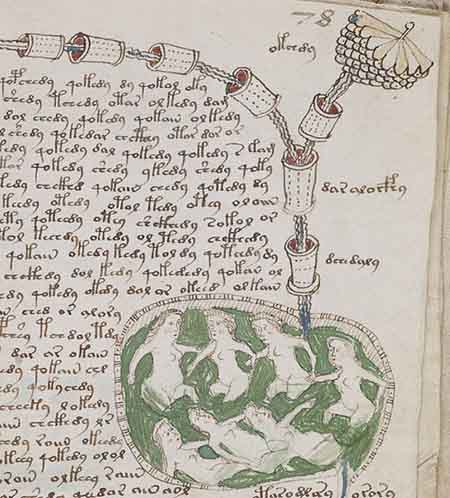
A dense continuous text interspersed with figures, mostly showing small naked women, some wearing crowns, bathing in pools or tubs connected by an elaborate network of pipes, some of them strongly reminiscent of body organs. The basins and tubes in the "biological" section may seem to indicate a connection to alchemy, which would also be relevant if the book contained instructions on the preparation of medical compounds. However, alchemical books of the period share a common pictorial language, where processes and materials are represented by specific images (eagle, toad, man in tomb, couple in bed, etc.) or standard textual symbols (circle with cross, etc.); and none of these could be convincingly identified in the Voynich manuscript.
Voynich Manuscript Finally Decoded? Medieval Sex Secrets May Hide in Mysterious Text Science Alert - April 17, 2024

The Voynich manuscript has long puzzled and fascinated historians and the public. This late-medieval document is covered in illustrations of stars and planets, plants, zodiac symbols, naked women, and blue and green fluids. But the text itself - thought to be the work of five different scribes - is enciphered and yet to be understood.
Research on the Voynich manuscript has revealed some clues about its origins. Carbon dating provides a 95% probability the skins used to make the manuscript come from animals that died between 1404 and 1438. However, its earliest securely known owner was an associate of Holy Roman Emperor Rudolf II, who lived from 1552 to 1612, which leaves more than a century of ownership missing. Certain illustrations (the zodiac symbols, a crown design and a particular shape of castle wall called a swallowtail merlon) indicate the manuscript was made in the southern Germanic or northern Italian cultural areas.
One section contains illustrations of naked women holding objects adjacent to, or oriented towards, their genitalia. These wouldn't belong in a solely herbal or astronomical manuscript. To make sense of these images, we investigated the culture of late-medieval gynecology and sexology Ð which physicians at the time often referred to as "women's secrets".
Author of mysterious Voynich manuscript was Italian Jew, says scholar The Guardian - July 7, 2017

One of the world's most confounding literary mysteries may finally be, in part, solved: the author of the mysterious and as-yet untranslatable Voynich manuscript has been identified as a Jewish physician based in northern Italy, an expert in medieval manuscripts has claimed. The Voynich manuscript is an illustrated book printed on vellum written entirely in an indecipherable script, leaving scholars and code-breakers scratching their heads since it re-emerged a century ago. Writing in the foreword of a new facsimile of the 15th-century codex, Stephen Skinner claims visual clues in each section provide evidence of the manuscript's author. If proved true, Skinner believes his theory will help unlock more secrets of the coded manuscript.
The scholar draws evidence for his theory of the author's identity from a range of illustrations in the manuscript, particularly a section in which naked women are depicted bathing in green pools supplied by intestinal-like pipes. The doctor, whose work includes editing the spiritual diaries of the Tudor mystic John Dee, believes the illustrations show communal Jewish baths called mikvah, which are still used in Orthodox Judaism to clean women after childbirth or menstruation.
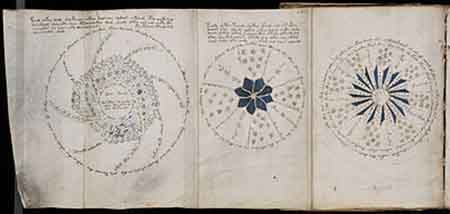
Contains circular diagrams, some of them with suns, moons, and stars, suggestive of astronomy or astrology. One series of 12 diagrams depicts conventional symbols for the zodiacal constellations (two fish for Pisces, a bull for Taurus, a hunter with crossbow for Sagittarius, etc.). Each of these has 30 female figures arranged in two or more concentric bands. Most of the females are at least partly naked, and each holds what appears to be a labeled star or is shown with the star attached by what could be a tether or cord of some kind to either arm. The last two pages of this section (Aquarius and Capricornus, roughly January and February) were lost, while Aries and Taurus are split into four paired diagrams with 15 women and 15 stars each. Some of these diagrams are on fold-out pages.
A circular drawing in the "astronomical" section depicts an irregularly shaped object with four curved arms, which some have interpreted as a picture of a galaxy that could only be obtained with a telescope. Other drawings were interpreted as cells seen through a microscope. This would suggest an early modern, rather than a medieval, date for the manuscript's origin. However, the resemblance is rather questionable: on close inspection, the central part of the "galaxy" looks rather like a pool of water.
10 Words in Mysterious Voynich Manuscript Decoded Live Science - February 21, 2014
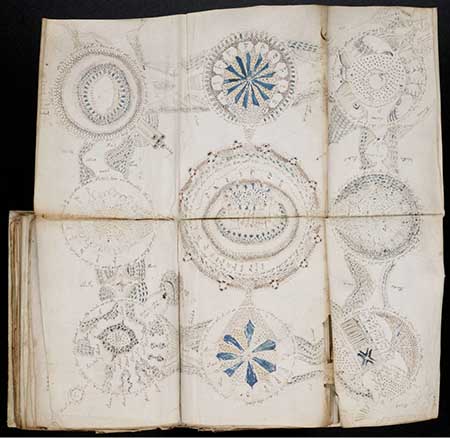
A researcher claims he's decoded 10 possible words in the famously unreadable Voynich manuscript, which has eluded interpretation for a century. The book's 250 vellum pages are filled with writings in an unknown alphabet and elaborate drawings depicting a range of subjects from female nudes to medicinal herbs to Zodiac symbols. The medieval text was discovered by an antique book dealer in 1912, and it has been rather stingy in giving up its secrets ever since. Now Stephen Bax, a professor of applied linguistics at the University of Bedfordshire in England, says he's deciphered 14 characters of the script and can read a handful of items in the Voynich text, such as the words for coriander, hellebore and juniper next to drawings of the plants. He says he's also picked out the word for Taurus written beside an illustration of the Pleiades, a star cluster in the constellation Taurus.
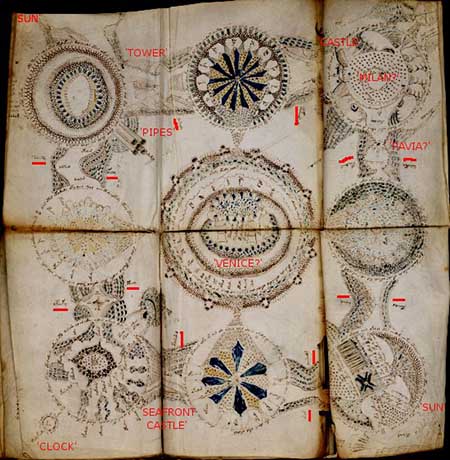
More circular diagrams, but of an obscure nature. This section also has foldouts; one of them spans six pages and contains a map or diagram, with nine "islands" or "rosettes" connected by "causeways" and containing castles, as well as what may possibly be a volcano.
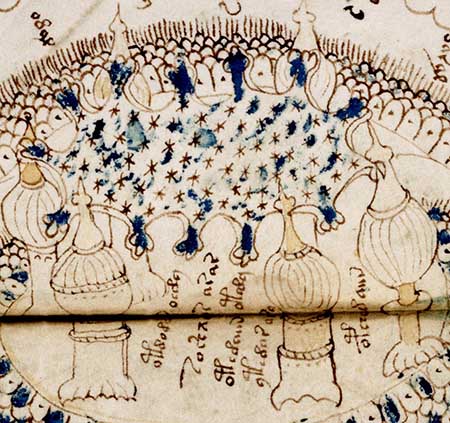
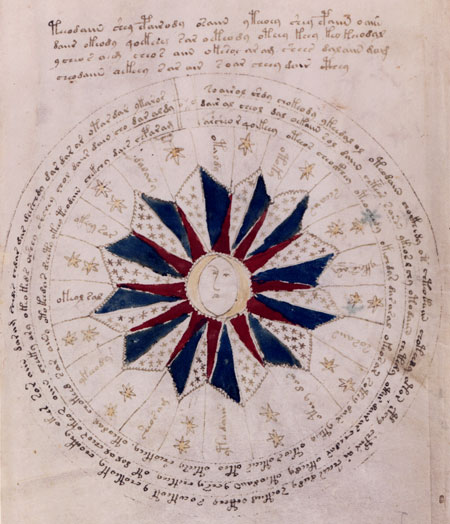
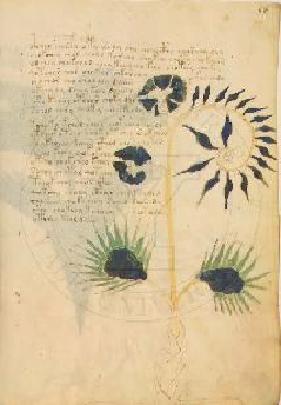
Sacred Geometry - Fibonacci Spirals
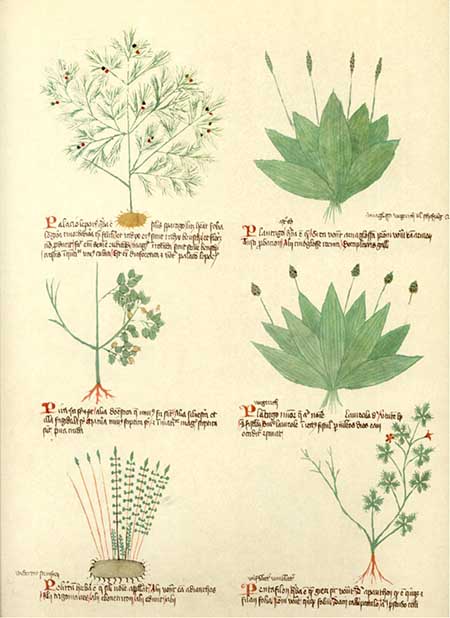
The first section of the book is almost certainly an herbal, but attempts to identify the plants, either with actual specimens or with the stylized drawings of contemporary herbals, have largely failed. Only a couple of plants (including a wild pansy and the maidenhair fern) can be identified with some certainty. Those "herbal" pictures that match "pharmacological" sketches appear to be "clean copies" of these, except that missing parts were completed with improbable-looking details.
In fact, many of the plants seem to be composite: the roots of one species have been fastened to the leaves of another, with flowers from a third. Each page displays one plant (sometimes two) and a few paragraphs of text - a format typical of European herbals of the time. Some parts of these drawings are larger and cleaner copies of sketches seen in the "pharmaceutical" section. None of the plants depicted are unambiguously identifiable.
Have we found the key to the mysterious Voynich Manuscript code? Gizmodo - February 3, 2014
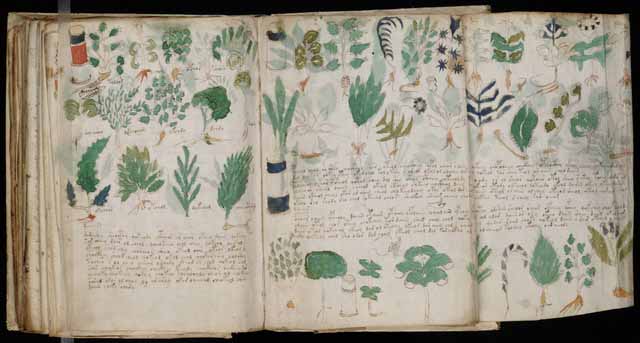
The mysterious, 15th century Voynich Manuscript is full of codes and bizarre illustrations. Most experts believe it's a hoax, a nonsense book created to fire our imaginations. But now there's new evidence that it may be written in a lost Aztec language, Nahuatl. Don't get too excited - people have been saying they've unlocked the code to the Voynich Manuscript for decades. It's such a common idea that it's turned up in fantasy tales from Codex, by Lev Grossman, to Assassin's Creed. But now, reports Lisa Grossman in New Scientist, there's a new wrinkle. A botanist named Arthur Tucker has discovered that several of the plant illustrations in the Voynich Manuscript look like plants found only in the New World.
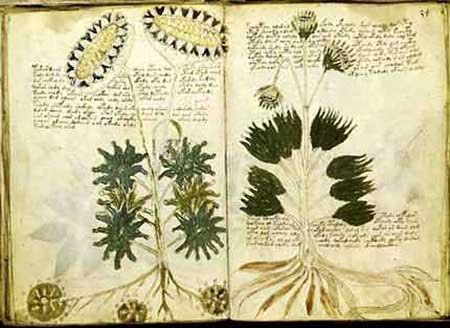
Many labeled drawings of isolated plant parts (roots, leaves, etc.); objects resembling apothecary jars, ranging in style from the mundane to the fantastical; and a few text paragraphs. The overall impression given by the surviving leaves of the manuscript is that it was meant to serve as a pharmacopoeia or to address topics in medieval or early modern medicine. However, the puzzling details of illustrations have fueled many theories about the book's origins, the contents of its text, and the purpose for which it was intended.
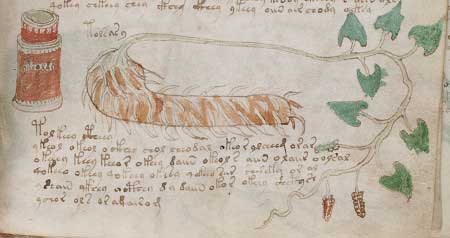
Many short paragraphs, each marked with a flower- or star-like "bullet".

The text was clearly written from left to right, with a slightly ragged right margin. Longer sections are broken into paragraphs, sometimes with star- or flower-like "bullets" in the left margin. There is no obvious punctuation, and no indications of any errors or corrections made at any place in the document. The ductus flows smoothly, giving the impression that the symbols were not enciphered, as there is no delay between characters as would normally be expected in written encoded text. Whoever the scribe was, he or she was practiced in writing the script. However, such writing fluency could also be achieved by copying prepared coded text from some other source, such as a wax tablet or separate manuscript.
The text consists of over 170,000 glyphs, usually separated from each other by narrow gaps. Most of the glyphs are written with one or two simple pen strokes. While there is some dispute as to whether certain glyphs are distinct or not, an alphabet with 20Ð30 glyphs would account for virtually all of the text; the exceptions are a few dozen rarer characters that occur only once or twice each.
Various transcription alphabets have been created, to equate the Voynich glyphs with Latin characters in order to help with cryptanalysis, such as the European Voynich Alphabet. The first major one was created by cryptographer William F. Friedman in the 1940s, where each line of the manuscript was transcribed to an IBM punch card to make it machine-readable.
Wider gaps divide the text into about 35,000 "words" of varying length. These seem to follow phonological or orthographic laws of some sort, e.g., certain characters must appear in each word (like English vowels), some characters never follow others, some may be doubled or tripled but others may not, etc.
Statistical analysis of the text reveals patterns similar to those of natural languages. For instance, the word entropy (about 10 bits per word) is similar to that of English or Latin texts. Some words occur only in certain sections, or in only a few pages; others occur throughout the manuscript. There are very few repetitions among the thousand or so "labels" attached to the illustrations.
On the other hand, the Voynich manuscript's "language" is quite unlike European languages in several aspects. There are practically no words comprising more than ten glyphs. The distribution of letters within words is also rather peculiar: some characters occur only at the beginning of a word, some only at the end, and some always in the middle section. While Semitic alphabets have many letters that are written differently depending on whether they occur at the beginning, in the middle or at the end of a word, letters of the Latin, Cyrillic, and Greek alphabets are generally written the same way regardless of their position within a word (with the Greek letter sigma and the obsolete long s being notable exceptions).
The text seems to be more repetitive than typical European languages; there are instances where the same common word appears up to three times in a row. Words that differ by only one letter also repeat with unusual frequency, causing single-substitution alphabet decipherings to yield babble-like text. Elizabeth Friedman in 1962 described such attempts as "doomed to utter frustration".
There are only a few words in the manuscript written in a seemingly Latin script. On the last page, there are four lines of writing written in rather distorted Latin letters, except for two words in the main script. The lettering resembles European alphabets of the late 14th and 15th centuries, but the words do not seem to make sense in any language. Also, a series of diagrams in the "astronomical" section has the names of ten of the months (from March to December) written in Latin script, with spelling suggestive of the medieval languages of France, northwest Italy or the Iberian Peninsula. However, it is not known whether these bits of Latin script were part of the original text or were added later.
It is an alphabetic script, but of an alphabet variously reckoned to have from nineteen to twenty-eight letters, none of which bear any relationship to any English or European letter system. The text has no apparent corrections. There is evidence for two different "languages" (investigated by Currier and D'Imperio) and more than one scribe, probably indicating an ambiguous coding scheme.